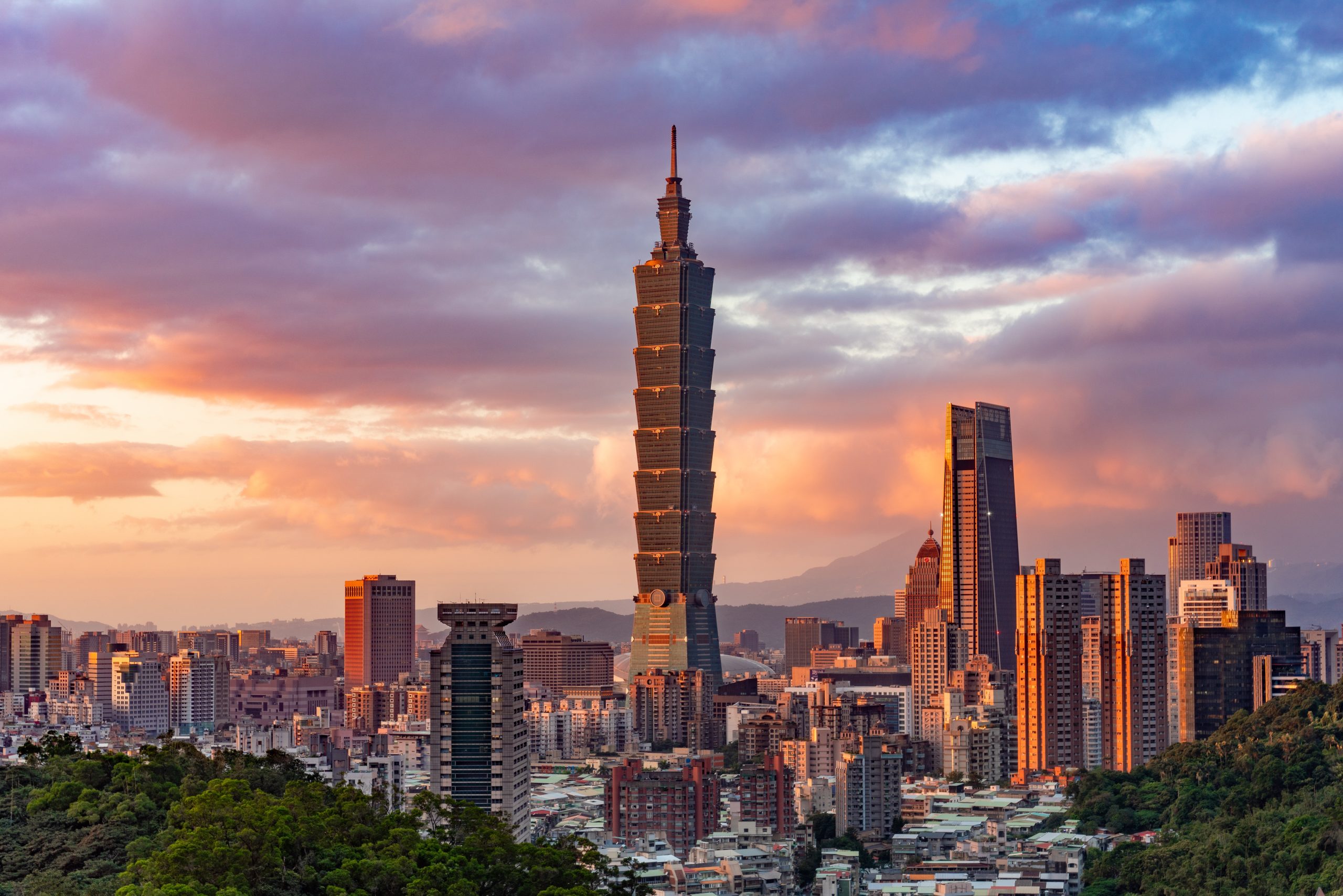63 East Asia: Political Geography II – The Two-China Dilemma
The indigenous people of Taiwan, who today account for just over 2% of the country’s population, have occupied the island for more than 6,000 years. Most of the rest of Taiwan’s population is Chinese. About 70% of the island’s population have ancestors who migrated from China’s mainland prior to 1949, and usually centuries before that. The rest of Taiwan’s Chinese population is descended from the 1.5 million refugees who fled mainland China following the communist takeover there in 1949.
Those refugees included Chiang Kai-Shek, the president of the Republic of China (ROC), and many of his nationalist supporters. On the mainland, communists led by Mao Zedong established the People’s Republic of China (PRC), and for years Chiang and his nationalists spoke of liberating the mainland from the communists. Taiwan’s desire to invade the mainland largely died with Chiang and his generation in the 1970s, but Taiwan is still officially known as the Republic of China, and the mainland government still claims Taiwan as its rightful territory. For more than seven decades, the international community has faced a “Two-China Dilemma.” Taiwan is an independent country in just about every sense of the word, but it has never formally declared independence from the mainland, largely because China’s mainland government has promised to invade the island if it does. Taiwan’s independence is not officially recognized by the United Nations or any major country, including Taiwan itself.
Taiwan Before 1949
The first Chinese communities in Taiwan were established sometime between the 7th and 12th centuries CE, but Chinese migrants would not outnumber Taiwan’s indigenous population for a few more centuries. Taiwan was colonized by the Netherlands in 1642. Shortly thereafter, the mainland’s Ming Dynasty was overthrown by the Manchu, and a number of Ming loyalists fled to Taiwan. In 1662, Ming soldiers fought a battle with the Dutch colonizers, forcing them from the island. Taiwan’s new Chinese rulers encouraged immigration from the mainland, and soon the Chinese were the island’s largest ethnic group. In 1683, China’s Manchu government conquered Taiwan, and it fell under formal control of mainland China for the first time.
In 1895, Japan defeated China in the Sino-Japanese War, and received control of Taiwan as part of the war’s settlement. Japanese administration of the island was at times harsh, but Taiwan benefitted economically from their new rulers. Japan had emerged as the most industrialized country in Asia, its levels of economic and technological modernization on par with those of North America and Western Europe. Japan unleashed its scientific and technological power in Taiwan, establishing factories and modernizing the island’s agriculture, education systems, and infrastructure. Soon, Taiwan would be the most modernized place in East Asia, second only to Japan itself.
With Japan’s defeat in World War II, control of Taiwan was handed back to China. Taiwan was largely neglected by the ROC government, which was preoccupied with its civil war against the communists. Taiwan’s once vibrant economy began to decline.
Taiwan Since 1949
When Chiang and the ROC government fled to Taiwan, their future was very much in doubt. The mainland communists seemed poised to invade. The United States expressed little interest in defending Taiwan, largely because it was far more concerned about the threat of Soviet expansion into western Europe.
Then, in 1950, North Korea invaded South Korea. As the U.S. rushed to contain communist expansion in Asia, a military alliance with Taiwan, an “unsinkable aircraft carrier,” became incredibly valuable. The U.S. Seventh Fleet was dispatched to the Strait of Taiwan, a 100-mile-wide body of water that separates Taiwan from the mainland, ending the threat of a communist invasion of the island. To further cement an alliance with Taiwan, the United States ensured that China’s seat in the United Nations would remain in the hands of Chiang’s ROC government, and not Mao’s PRC government. In 1954, the U.S. officially pledged military protection to Taiwan.
By the 1960s, Taiwan’s industrial economy had been revived. It would soon be one of the world’s most productive and wealthy economies. Taiwan also began a long, slow transformation into a legitimate democracy. Soon, however, it would face an unexpected political crisis.
In the late 1960s, it became clear to the United States that it was losing the war in Vietnam. At the same time, the relationship between the communist governments of the Soviet Union and mainland China had soured considerably. The United States decided it could offset the geopolitical damage of a Soviet-backed victory in Vietnam by drawing China out the Soviet orbit. Put simply, the U.S. decided it needed to “play nice” with mainland China’s government.
In 1971, the U.S. government stunned Taiwan by recommending the ROC’s seat in the United Nations be given to the PRC government Beijing, and it eventually was. The next year, Richard Nixon became the first American president to travel to mainland China. In 1978, the United States announced it was severing its official diplomatic ties with Taiwan and normalizing relations with the mainland. Other countries soon followed suit, and the “Two-China Dilemma” deepened. The United States still traded heavily with Taiwan, and it was still committed to its military defense, but no longer officially recognized its independence.
In the 1980s, the two Chinas developed a friendlier relationship. Travel between the two countries was first permitted in 1987, and the following year they agreed to open their markets to one another. Taiwan and China soon became major trading partners, an odd fact given that they were still technically in a state of civil war.

Photo by Timo Volz on Unsplash.
Despite their important economic relationship, the political relationship between the two countries has frequently gotten tense. In 1995, Taiwan’s president travelled to the U.S. to deliver a speech at Cornell University, his alma mater. It was not an official state visit, but it infuriated the mainland government, which viewed the trip as Taiwan’s attempt to re-establish official diplomatic ties with the United States. China responded by conducting missile tests in the Strait of Taiwan. The U.S. dispatched warships to the Strait, bringing the two countries to the brink of a military engagement. Beijing was further angered in 1999, when Taiwan’s president recommended the two countries normalize diplomatic relations, which suggested that Taiwan was an independent country. And indeed, an increasing number of Taiwanese citizens, particularly younger people, believed their country should formalize its separation from the mainland.
In recent years, China’s threats toward Taiwan have increased. Chinese military aircraft have repeatedly violated Taiwan’s airspace, and the Chinese army has conducted military drills along the Strait of Taiwan. Beijing recently declared that the Strait was sovereign territory of China, and not in international waters. While there is no evidence that China is planning an invasion of Taiwan, it appears more likely now than it has for decades. Taiwan’s greatest concern might China’s recent economic misfortunes. If a declining economy threatens President Xi Jinping’s grip on power, he may start a war in Taiwan to solidify public support for his regime. The United States has responded to Xi’s threats by increasing its naval patrols in the Strait of Taiwan – it has conducted thirty in the last two years alone. The navies of American allies – Britain, France, Canada, and Australia – have done the same, a not-too-subtle reminder to China that the West is committed to Taiwan’s defense.
Many believe that President Xi is looking to Russia’s war in Ukraine as a sort of litmus test. If Western sanctions successfully cripple Russia’s war effort, and if the outnumbered but highly motivated Ukrainian forces are able to successfully repel the invading Russians, Xi will likely be dissuaded from moving against Taiwan. But if Russia’s efforts are successful, it may inspire Xi to invade. Currently, U.S. and Taiwanese officials are focused on transforming Taiwan into a “porcupine,” an island bristling with so many defensive weapons that it would be too painful for China to invade. In 2020, Taiwan purchased $5 billion worth of weapons from the United States – double its usual annual spending.
Did you know?
My Turn!
CITED AND ADDITIONAL BIBLIOGRAPHY:
Eversden, Andrew. “As Pelosi Arrives in Taiwan, the Big Question Is If China’s ‘fire’ Rhetoric Is Just Hot Air.” Breaking Defense, 2 Aug. 2022, https://breakingdefense.sites.breakingmedia.com/2022/08/as-pelosi-arrives-in-taiwan-the-big-question-is-if-chinas-fire-rhetoric-is-just-hot-air/.


